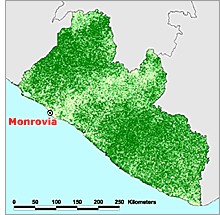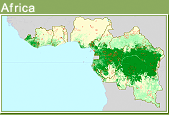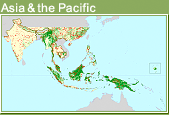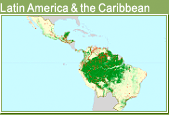Country details
Status of Tropical Forest Management 2005
Africa
Liberia

©UNEP-WCMC 2004
Liberia is blessed with a rich forest resource, a substantial part of which, however, has been lost or degraded in recent years during civil war. Once the country emerges from its political problems, a newly reconstituted and restructured forest sector, built on the pillars of accountability and transparency, could play a major role in economic growth and sustainable development. But its success will depend very much on strong political will and international support.
Key points
- Liberia's PFE covers an estimated 1.41 million hectares, comprising 1.31 million hectares of natural-forest production PFE and 101,000 hectares of protection PFE. More forest could be committed to the PFE from the presently uncommitted area of about 2 million hectares.
- None of the PFE is currently thought to be under SFM.
- The existing protection PFE comprises less than 3% of the country's forests.
- The UN Security Council imposed an embargo on the export of timber from Liberia in 2003 and it remains in force. The embargo was designed to minimize the extent to which revenues from timber exports contributed to private militias.
- In the past, the Liberian forestry sector has generated up to a quarter or more of GDP, but this has declined due to the embargo and the general disarray of the sector.
- There are few or no reliable inventory data available to facilitate forest management.
- The Forest Development Authority (FDA) is responsible for overseeing the forestry sector, but it is seriously under-resourced.
- The FDA has recently attempted to review concession agreements and decide which are legitimate, a difficult task since many files were lost or destroyed during the civil war.
- There is strong support across a range of stakeholders for community-based forest management and greater benefit-sharing with rural people.
- No silvicultural system has been devised for Liberian forests other than a selective logging regime. The prescribed felling cycle of 25 years is relatively short.
- Much of the timber-processing capacity and other infrastructure was destroyed during the civil war and is yet to be rebuilt.

 Africa
Africa  Asia & the Pacific
Asia & the Pacific  Latin America & the Caribbean
Latin America & the Caribbean